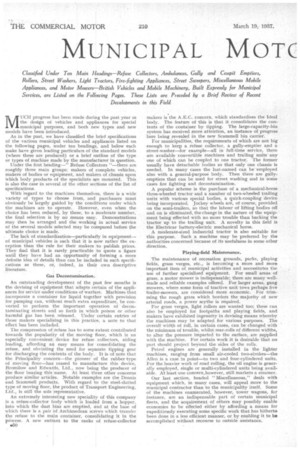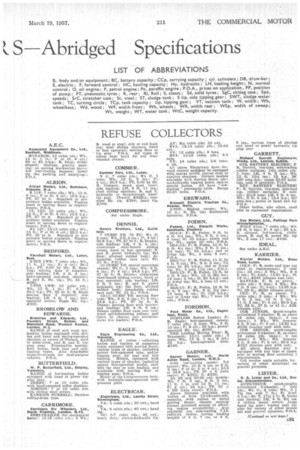Mu \TICIPAL MOTE
Page 100

Page 101

If you've noticed an error in this article please click here to report it so we can fix it.
S -Abridged Specifications
Classified Under Ten Main Headings—Refuse Collectors, Ambulances, Gully and Cesspit Emptiers, Rollers, Street Washers, Light Tractors, Fire-fighting Appliances, Street Sweepers, Miscellaneous Mobile Appliances, and Motor Mowers—British Vehicles and Mobile Machinery, Built Expressly for Municipal Services, are Listed on the Following Pages. These Lists are Preceded by a Brief Review of Recent Developments in this Field MLICH progress has been made during the past year 311 the design of vehicles and appliances for special municipal purposes, and both new types and new models have been introduced.
As in the past, we have classified the brief specifications of the various municipal vehicles and appliances listed on the following pages, under ten headings, and below each make have given leading particulars of the standard models (where these are produced) or a brief outline of the type or types of machine made by the manufacturer in question.
Under the first heading—" Refuse Collectors "—there are roughly three main groups: makers of complete vehicles, makers of bodies or equipment, and makers of chassis upon which body products of the specialists are mounted. This is also the case in several of the other sections of the list of specifications.
With -regard to the machines themselves, there is a wide variety of types to choose from, and purchasers must obviously be largely guided by the conditions under which the machines are to operate. However, even when the choice has been reduced, by these, to a moderate number, the final selection is by no means easy. Demonstrations may then be arranged and the working in actual service of the several models selected may be compared before the ultimate choice is made.
The lack of standardization—particularly in equipment—. of municipal vehicles is such that it is now rather the exception than the rule for their makers to publish prices. They find that it is rarely practicable to quote a figure until they have had an opportunity of forming a more definite idea of details than can be included in such specifications as these, or, indeed, in their own descriptive literature.
Gas Decontamination.
An outstanding development of the past few months is the devising of equipment that adapts certain of the appliances for service under conditions of warfare. Machines that incorporate a container for liquid together with provision for pumping can, without much extra expenditure, be converted to perform the important operation of decontaminating streets and so forth in which poison or other harmful gas has been released. Under certain entries of those makers specializing in this practice, a note to that effect has been included.
The compression of refuse has to some extent contributed towards the popularity of the moving floor, which is an especially convenient device for refuse collectors, aiding loading, affording an easy means for consolidating the refuse, and obviating the need for separate tipping gear for discharging the contents of the body. It is of note that the Principality concern—the pioneer of the rubber type of moving floor—has ceased to manufacture this device, Bromilow and Edwards, Ltd., now being the producer of the floor bearing this name. At least three other concerns produce similar articles. Notable examples are the Dennis and Scararnell products, With regard to the steel-slatted type of moving floor, the product of Transport Engineering, Ltd., is still the sole representative.
An extremely interesting new speciality of this company is a refuse-collector body which is loaded from a hopper, into which the dust bins are emptied, and at the base of which there is a pair of Archimedean screws which transfer the refuse to the main container, consolidating it in the process. A new entrant to the ranks of refuse-collector 650 makers is the A.E.C. concern, which standardizes the Ideal body. The feature of this is that it consolidates the contents of the container by tipping. The large-capacity-bin system has received more attention, an instance of progress here being revealed in the new Seanunell bin carrier'.
For municipalities, the requirements of which are not big enough to keep a refuse collector, a gully-emptier and a street-washer—for example—all in full-time service, there are available 'convertible machines and trailing units any one of which can be coupled to one tractor. The former usually have detachable bodies so that only one chassis is needed. In many cases the last-named can be employed also with a general-purpose body. Then there are gullyemptiers that can be used for street washing and in Some cases fire fighting and decontamination.
A popular scheme is the purchase of a mechanical-horse three-wheeled tractor and a number of two-wheeled trailing units with various special bodies, a quick-coupling device being incorporated. Jockey wheels are, of course, provided on the semi-trailers, so that the labour of lifting bodies off and on is eliminated, the change in the nature of the equip• ment being effected with no more trouble than backing the tractor up to the trailing unit. A novelty in this field is the Electricar battery-electric mechanical horse.
A moderate-sized industrial tractor is also suitable for this purpose. Such a machine may be preferred by the authorities concerned because of its usefulness in some other direction.
Playing-field Maintenance.
The maintenance of recreation grounds, parks, playing fields, grass verges, etc., is becoming • a more and more important item of municipal activities and necessitates the use of further specialized equipment. For small areas of grass, a motor mower is indispensable; there are many wellmade and reliable examples offered. For larger areas, gang mowers, where some form of tractive unit tows perhaps five trailer-mowers, are considered more economic. For trimming the rough grass which borders themajority of new arterial roads, a power scythe is required.
For grass verges, light rollers are wanted too; these can also be employed for footpaths arid playing fields, and makers have exhibited ingenuity in devising means whereby the machines may be adapted for various purposes. The overall width of roll, in certain cases, can be changed with the minimum of trouble, whilst rear-rolls of different widths, to alter the pressure imparted to the surface, arc supplied with the machine. For certain work it is desirable that no part should project beyond the sides of the rolls.
Petrol engines are generally installed in the lighter machines, ranging from small air-cooled two-strokes--the Allen is a case in point—to two and four-cylindered units. For the heavier work of road rolling, the oil engine is generally employed, single or multi-cylindered units being available. At least one concern,however, still markets a steamer.
Our last section, headed "Miscellaneous," deals with equipment which, in many cases, will appeal more to the municipal contractor than to the municipality itself. Some of the machines enumerated, however, tower wagons, for instance, are an indispensable part of certain municipal fleets, and the acquirement of others may possibly enable economies to be effected either by affording a means for expeditiously executing some specific work that has hitherto been done in a less efficient manner, or by enabling it to be accomplished without recourse to outside assistance.
























































































































































